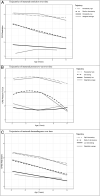Trajectories of Picky Eating in Low-Income US Children
- PMID: 32457215
- PMCID: PMC7263050
- DOI: 10.1542/peds.2019-2018
Trajectories of Picky Eating in Low-Income US Children
Abstract
Background and objectives: Picky eating is common, yet little is known about trajectories of picky eating in childhood. Our objectives were to examine trajectories of child picky eating in low-income US children from ages 4 to 9 years and associations of those trajectories with participant characteristics, including child BMI z score (BMIz) and maternal feeding-behavior trajectories.
Methods: Mother-child dyads (N = 317) provided anthropometry and reported on picky eating and maternal feeding behaviors via questionnaires at child ages 4, 5, 6, 8, and 9 years. At baseline, mothers reported on demographics and child emotional regulation. Trajectories of picky eating and maternal feeding behaviors were identified by using latent class analysis. Bivariate analyses examined associations of picky-eating trajectory membership with baseline characteristics and maternal feeding-behavior trajectory memberships. A linear mixed model was used to examine the association of BMIz with picky-eating trajectories.
Results: Three trajectories of picky eating emerged: persistently low (n = 92; 29%), persistently medium (n = 181; 57%), and persistently high (n = 44; 14%). Membership in the high picky-eating trajectory was associated with higher child emotional lability and lower child emotional regulation. Picky eating was associated with restriction (P = .01) and demandingness (P < .001) trajectory memberships, such that low picky eating was associated with low restriction and high picky eating was associated with high demandingness. Medium and high picky-eating trajectories were associated with lower BMIz.
Conclusions: Picky eating appears to be traitlike in childhood and may be protective against higher BMIz.
Copyright © 2020 by the American Academy of Pediatrics.
Conflict of interest statement
POTENTIAL CONFLICT OF INTEREST: The authors have indicated they have no potential conflicts of interest to disclose.
Figures


Comment in
-
The Persistence of Picky Eating: Opportunities to Improve Our Strategies and Messaging.Pediatrics. 2020 Jun;145(6):e20200893. doi: 10.1542/peds.2020-0893. Pediatrics. 2020. PMID: 32457217 Free PMC article. No abstract available.
References
-
- Carruth BR, Ziegler PJ, Gordon A, Barr SI. Prevalence of picky eaters among infants and toddlers and their caregivers’ decisions about offering a new food. J Am Diet Assoc. 2004;104(1 suppl 1):s57–s64 - PubMed
-
- Taylor CM, Wernimont SM, Northstone K, Emmett PM. Picky/fussy eating in children: review of definitions, assessment, prevalence and dietary intakes. Appetite. 2015;95:349–359 - PubMed
-
- Cardona Cano S, Tiemeier H, Van Hoeken D, et al. . Trajectories of picky eating during childhood: a general population study. Int J Eat Disord. 2015;48(6):570–579 - PubMed
Publication types
MeSH terms
Grants and funding
LinkOut - more resources
Full Text Sources

